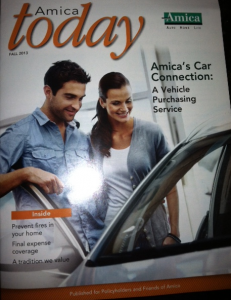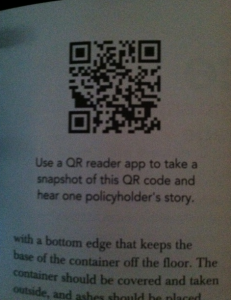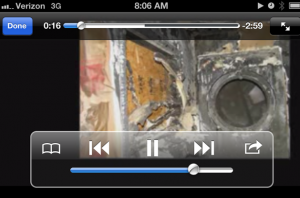QR Codes and Publishing Case Study: Amica Insurance
Posted on by Timothy Boyle I have been a loyal Amica Insurance customer for many years now, and I really have no complaints. They have been less expensive than anyone else I have compared policies to, have great customer service and are a mutual company (meaning they are owned by the policy holders and not stock holders). Really not sure why I would ever switch. But every so often they send me what is basically a short magazine on the happenings around Amica Insurance Company and relevant information that might be beneficial for policy holders to know. For example, one article in the magazine is about tips for preventing home fires. It is a nice short and informative publication, but the thing that caught my eye was the QR code placed next to one of the articles. And it will be a perfect case study for us to see the value of QR codes in printed publications.
I have been a loyal Amica Insurance customer for many years now, and I really have no complaints. They have been less expensive than anyone else I have compared policies to, have great customer service and are a mutual company (meaning they are owned by the policy holders and not stock holders). Really not sure why I would ever switch. But every so often they send me what is basically a short magazine on the happenings around Amica Insurance Company and relevant information that might be beneficial for policy holders to know. For example, one article in the magazine is about tips for preventing home fires. It is a nice short and informative publication, but the thing that caught my eye was the QR code placed next to one of the articles. And it will be a perfect case study for us to see the value of QR codes in printed publications.
The QR code was placed next to the article on fire safety tips, and like any good QR code user the code follows all of the typical best practices. The code is clearly visible, has a low density for easy scanning, and has a particularly great call to action. What is so good about the call to action is that it tells you exactly what you are going to get upon scanning the code and how to go about scanning it. In this case the call to action says it will take you to hear more about one policyholder’s story.
 Upon scanning the code you are taken directly to a youtube video about a policyholder and his family’s experience of going through a home fire and how Amica was incredibly helpful through the whole situation. It was a great way for the viewer to see just how things might go for them if they are ever forced to make a claim. A great addition to the article; it was engaging, and more information than could have otherwise have been fit onto the page.
Upon scanning the code you are taken directly to a youtube video about a policyholder and his family’s experience of going through a home fire and how Amica was incredibly helpful through the whole situation. It was a great way for the viewer to see just how things might go for them if they are ever forced to make a claim. A great addition to the article; it was engaging, and more information than could have otherwise have been fit onto the page.
This use of a QR code in a publication is an absolutely perfect example of how QR codes and connected content can be, and should be, used in most printed publications. This ability to connect print content with the web is a great way to provide additional content, relevant information, or way for the reader to get engaged with the subject.
A newspaper for example might include a QR code next to a news story or opinion piece that lets the reader see an entire interview with a source rather than just a couple quotes that the physical limitations of print only allow. Or perhaps the QR directs the reader to various graphs or data about the topic at hand, or a past article on the same subject or whatever.
 A book, particularly non-fiction books, might use QR codes throughout the pages to do the same things as the newspaper and allow readers to have access to interviews, data, or other sources. Or maybe it takes the reader to a forum where readers can discuss the content and engage with each other. Really the options for QR codes in this format are awesome.
A book, particularly non-fiction books, might use QR codes throughout the pages to do the same things as the newspaper and allow readers to have access to interviews, data, or other sources. Or maybe it takes the reader to a forum where readers can discuss the content and engage with each other. Really the options for QR codes in this format are awesome.
Connecting the physical world of print to the digital world of almost unlimited space and information is a potentially great way of keeping print relevant and making sure it reaches its full potential, and doesn’t completely lose its relevancy.
Just make sure you have a platform that allows you to have dynamic codes, analytics, and lets you easily manage your codes all in one place.

